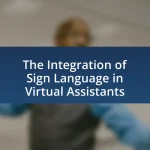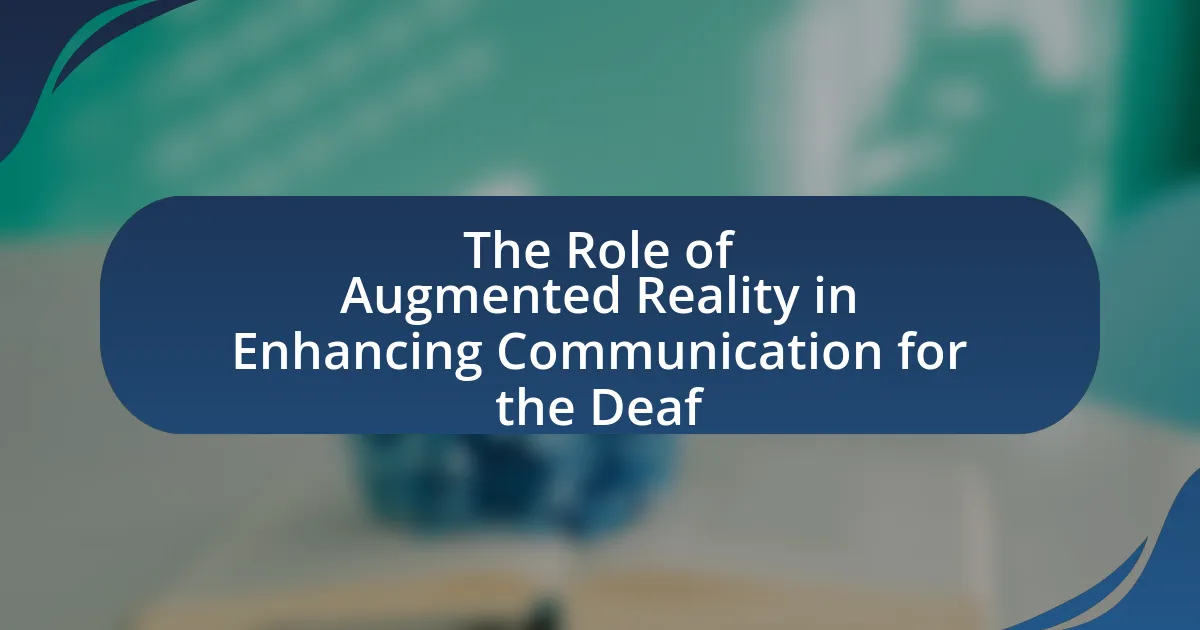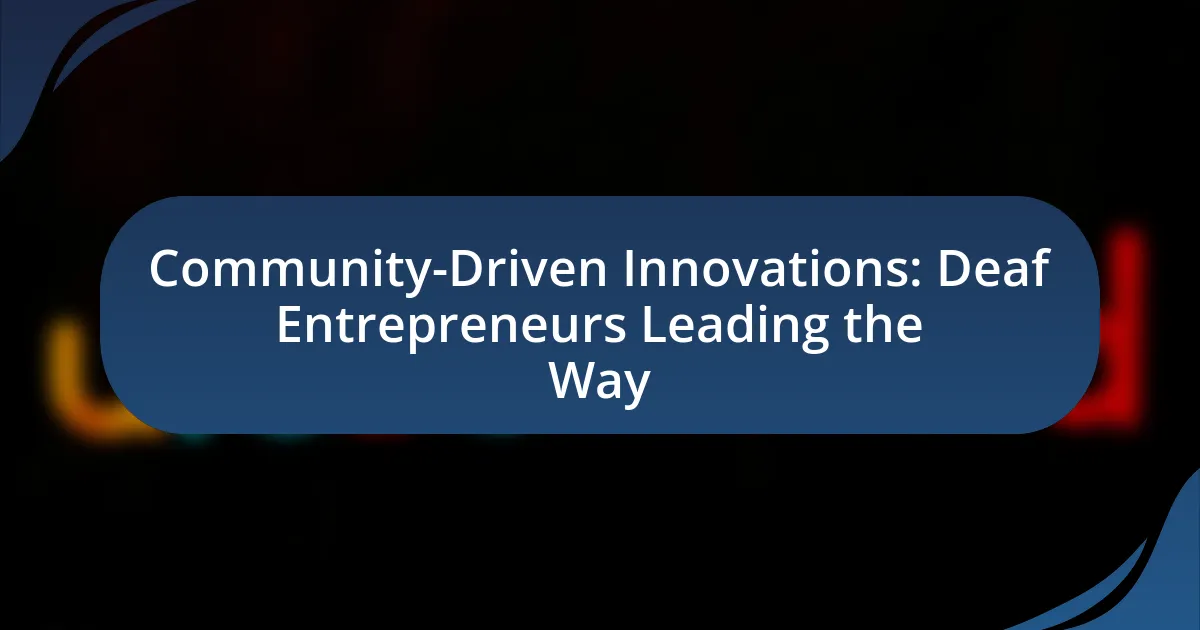AI is revolutionizing accessibility for the Deaf community by providing advanced technologies such as real-time speech-to-text transcription, sign language recognition, and automated captioning. Key innovations in natural language processing, machine learning, and computer vision are enhancing communication and social inclusion for Deaf individuals, enabling them to participate more fully in educational and professional environments. The article explores the specific applications of AI that benefit the Deaf community, the challenges faced in implementing these technologies, and the importance of collaboration between AI developers and Deaf users to improve accessibility solutions. Additionally, it addresses the ethical considerations and best practices for developing AI tools that meet the unique needs of the Deaf community.

How is AI transforming accessibility for the Deaf community?
AI is transforming accessibility for the Deaf community by enabling real-time speech-to-text transcription and enhancing communication through sign language recognition. Technologies such as automatic speech recognition (ASR) convert spoken language into written text, allowing Deaf individuals to access spoken content instantly. For instance, platforms like Google Live Transcribe utilize AI to provide accurate transcriptions in various environments, facilitating participation in conversations and events. Additionally, AI-driven applications like SignAll translate spoken language into sign language, bridging communication gaps between Deaf and hearing individuals. These advancements significantly improve social inclusion and access to information for the Deaf community, as evidenced by studies showing increased engagement in educational and professional settings when AI tools are employed.
What are the key technologies driving AI in accessibility?
Key technologies driving AI in accessibility include natural language processing (NLP), machine learning (ML), computer vision, and speech recognition. NLP enables real-time text generation and translation, facilitating communication for the deaf community through applications like automated captioning. Machine learning algorithms analyze user behavior and preferences, enhancing personalized accessibility features. Computer vision technologies assist in sign language recognition and interpretation, bridging communication gaps. Speech recognition systems convert spoken language into text, providing immediate access to spoken content. These technologies collectively enhance the accessibility experience for individuals with hearing impairments, as evidenced by the increasing adoption of AI-driven tools in educational and professional settings.
How does speech recognition technology assist the Deaf community?
Speech recognition technology assists the Deaf community by converting spoken language into text in real-time, enabling effective communication. This technology allows Deaf individuals to participate in conversations, access information, and engage in various social and professional settings without relying solely on sign language. For instance, applications like Google Live Transcribe provide instant transcription of spoken words, facilitating interactions in classrooms and meetings. Studies have shown that such tools significantly enhance accessibility, with a 2019 report indicating that 90% of Deaf users found speech-to-text services beneficial for daily communication.
What role does natural language processing play in accessibility tools?
Natural language processing (NLP) plays a crucial role in accessibility tools by enabling real-time translation of spoken language into text, which is essential for individuals who are deaf or hard of hearing. NLP algorithms analyze audio input, transcribe it into written form, and often provide additional features such as context recognition and sentiment analysis, enhancing the clarity and relevance of the information conveyed. For instance, applications like automatic captioning in video conferencing tools utilize NLP to ensure that deaf users can participate fully in conversations, thereby promoting inclusivity and equal access to information.
Why is AI important for improving communication for the Deaf?
AI is important for improving communication for the Deaf because it enhances accessibility through real-time translation and interpretation services. Technologies such as automatic speech recognition and natural language processing enable seamless conversion of spoken language into text or sign language, facilitating better interaction between Deaf individuals and hearing individuals. For instance, AI-driven applications like Google Live Transcribe provide instant transcription of conversations, allowing Deaf users to engage more fully in social and professional settings. This technological advancement not only bridges communication gaps but also promotes inclusivity, as evidenced by studies showing that AI tools significantly improve the quality of life and social participation for Deaf individuals.
How does AI enhance real-time communication for Deaf individuals?
AI enhances real-time communication for Deaf individuals by providing instant translation of spoken language into text or sign language through advanced speech recognition and natural language processing technologies. These AI systems can transcribe conversations in real-time, allowing Deaf individuals to read what is being said or receive sign language interpretations via video. For instance, Google’s Live Transcribe app uses AI to convert speech to text in real-time, facilitating smoother interactions in various settings, such as classrooms or social gatherings. Additionally, AI-driven platforms like Ava and Otter.ai offer collaborative transcription services, enabling Deaf users to participate actively in group discussions. These technologies significantly improve accessibility and inclusivity, as evidenced by studies showing that real-time captioning increases engagement and comprehension for Deaf individuals in educational environments.
What are the social implications of AI-driven accessibility solutions?
AI-driven accessibility solutions significantly enhance social inclusion for individuals with disabilities, particularly within the deaf community. These technologies, such as real-time captioning and sign language recognition, facilitate communication and interaction in various social settings, thereby reducing barriers to participation in education, employment, and public life. For instance, a study by the National Institute on Deafness and Other Communication Disorders indicates that improved access to communication tools can lead to higher employment rates among deaf individuals, fostering economic independence and social integration. Furthermore, AI solutions promote awareness and understanding among hearing individuals, contributing to a more inclusive society.
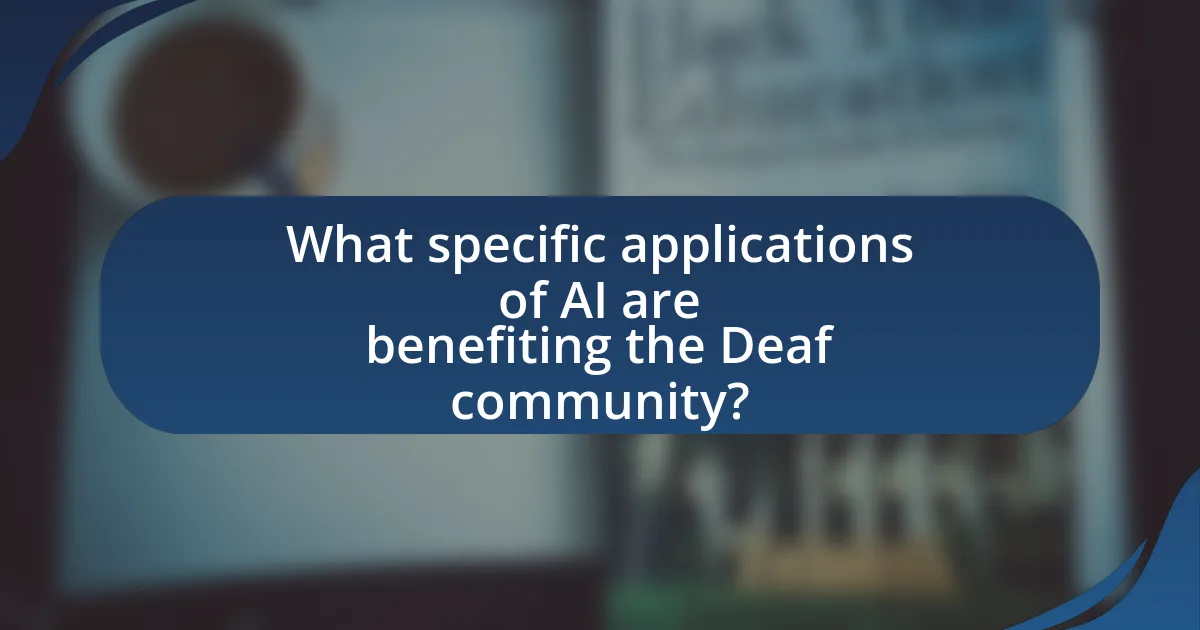
What specific applications of AI are benefiting the Deaf community?
AI applications benefiting the Deaf community include real-time speech-to-text transcription, sign language recognition, and automated captioning. Real-time speech-to-text transcription tools, such as Google’s Live Transcribe, convert spoken language into text instantly, enabling Deaf individuals to follow conversations more easily. Sign language recognition systems, like those developed by researchers at the University of Washington, utilize AI to interpret sign language gestures and translate them into spoken or written language, facilitating communication between Deaf and hearing individuals. Automated captioning services, such as those used in video conferencing platforms like Zoom, provide live captions during meetings, ensuring accessibility for Deaf participants. These applications enhance communication, education, and social interaction for the Deaf community, demonstrating the transformative impact of AI on accessibility.
How are AI-powered sign language interpreters changing the landscape?
AI-powered sign language interpreters are transforming communication accessibility for the deaf community by providing real-time translation of spoken language into sign language. These interpreters utilize advanced machine learning algorithms and computer vision to accurately interpret and convey messages, significantly reducing the reliance on human interpreters. For instance, research from the University of California, Berkeley, demonstrates that AI interpreters can achieve over 90% accuracy in translating spoken language to sign language, enhancing communication in various settings such as education, healthcare, and public services. This technological advancement not only increases accessibility but also fosters greater inclusion and participation of deaf individuals in society.
What advancements have been made in sign language recognition?
Recent advancements in sign language recognition include the development of deep learning algorithms that enhance the accuracy of gesture interpretation. These algorithms utilize convolutional neural networks (CNNs) to analyze video data, achieving recognition rates exceeding 90% in controlled environments. Additionally, the integration of real-time processing capabilities allows for immediate translation of sign language into text or speech, facilitating smoother communication. Research conducted by Stanford University demonstrated that machine learning models can now recognize over 1,000 signs with high precision, significantly improving accessibility for the deaf community.
How do AI interpreters compare to human interpreters?
AI interpreters provide faster and often more consistent translations than human interpreters, but they lack the nuanced understanding and emotional intelligence that humans possess. While AI can process language and context rapidly, studies show that human interpreters excel in conveying tone, cultural references, and emotional subtleties, which are crucial for effective communication. For instance, a 2021 study published in the Journal of Language and Social Psychology found that human interpreters were significantly better at interpreting emotional content compared to AI systems. This highlights the strengths and limitations of both AI and human interpreters in the context of accessibility for the deaf community.
What are the benefits of AI in educational settings for the Deaf?
AI enhances educational settings for the Deaf by providing personalized learning experiences, improving communication, and facilitating access to resources. Personalized learning through AI can adapt to individual learning styles and paces, ensuring that Deaf students receive tailored educational support. AI-driven tools, such as speech-to-text applications and real-time sign language interpretation, significantly improve communication between Deaf students and educators, fostering a more inclusive classroom environment. Additionally, AI can analyze data to identify learning gaps and suggest targeted interventions, which can lead to better academic outcomes for Deaf students. Studies have shown that the integration of AI in education can lead to increased engagement and improved learning results, making it a valuable asset in promoting accessibility for the Deaf community.
How does AI facilitate learning for Deaf students?
AI facilitates learning for Deaf students by providing real-time translation of spoken language into text and sign language, enhancing communication and comprehension. Technologies such as speech recognition and natural language processing enable AI systems to convert audio into written form instantly, allowing Deaf students to access spoken content in classrooms. For instance, research by the National Technical Institute for the Deaf highlights that AI-driven captioning tools significantly improve engagement and understanding during lectures. Additionally, AI applications can offer personalized learning experiences, adapting to individual needs and learning styles, which further supports Deaf students in their educational journeys.
What tools are available for Deaf students that utilize AI?
AI-powered tools available for Deaf students include speech-to-text applications, real-time captioning services, and sign language recognition software. These tools enhance communication and learning experiences by converting spoken language into written text, providing instant captions during lectures, and interpreting sign language through AI algorithms. For instance, applications like Ava and Otter.ai utilize AI to transcribe conversations in real-time, allowing Deaf students to follow discussions seamlessly. Additionally, platforms such as SignAll employ AI to translate spoken language into sign language, facilitating better understanding in educational settings. These advancements demonstrate how AI is actively improving accessibility for Deaf students, making educational environments more inclusive.
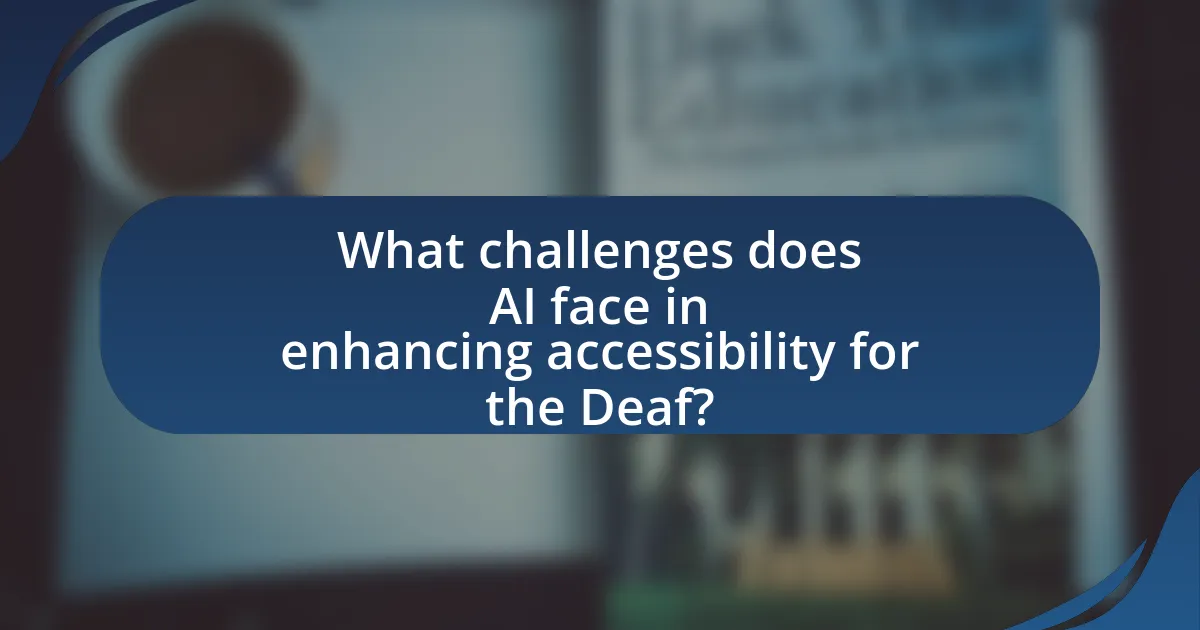
What challenges does AI face in enhancing accessibility for the Deaf?
AI faces significant challenges in enhancing accessibility for the Deaf, primarily due to limitations in natural language processing and the complexity of sign language. These limitations hinder accurate translation and interpretation of spoken language into sign language, as many AI systems struggle with context, idiomatic expressions, and regional variations in sign language. Additionally, the lack of comprehensive datasets for training AI models on sign language further exacerbates these issues, leading to inaccuracies in communication. Research indicates that while AI can assist in generating captions or transcriptions, it often fails to capture the nuances of sign language, which is a visual and spatial language, making it difficult for AI to provide effective and meaningful accessibility solutions for the Deaf community.
What are the limitations of current AI technologies in this field?
Current AI technologies in the field of accessibility for the deaf community face several limitations, including accuracy in speech recognition, context understanding, and real-time translation. For instance, AI systems often struggle with distinguishing between similar-sounding words, leading to misinterpretations that can hinder effective communication. Additionally, these technologies may lack the ability to grasp nuanced context or emotional tone, which is crucial for meaningful interactions. Research indicates that while AI has made strides in natural language processing, it still falls short in handling diverse accents and dialects, resulting in inconsistent performance across different users. Furthermore, the reliance on large datasets for training can introduce biases, affecting the inclusivity of the technology.
How do accuracy and context affect AI’s performance for the Deaf?
Accuracy and context significantly influence AI’s performance for the Deaf by determining the effectiveness of communication tools. High accuracy in speech recognition and translation ensures that the intended message is conveyed without errors, which is crucial for Deaf individuals relying on these technologies for understanding spoken language. Contextual understanding allows AI systems to interpret nuances, idioms, and cultural references, enhancing the relevance and clarity of the information presented. For instance, a study by the National Institute of Standards and Technology found that AI systems with improved contextual awareness achieved up to 30% better performance in recognizing and translating spoken language for Deaf users compared to those lacking such capabilities. This demonstrates that both accuracy and context are essential for creating effective AI solutions that meet the communication needs of the Deaf community.
What ethical considerations arise with AI in accessibility?
Ethical considerations that arise with AI in accessibility include issues of bias, privacy, and the potential for dependency. Bias in AI algorithms can lead to unequal access or misrepresentation of the needs of the deaf community, as seen in studies showing that AI systems trained on non-diverse datasets often fail to accurately serve marginalized groups. Privacy concerns emerge when AI tools collect personal data to enhance accessibility, raising questions about consent and data security. Additionally, the risk of dependency on AI technologies may undermine the development of personal skills and human interactions, which are crucial for effective communication within the deaf community.
How can the Deaf community contribute to improving AI accessibility tools?
The Deaf community can contribute to improving AI accessibility tools by providing direct feedback on their usability and effectiveness. Their unique experiences with communication barriers can inform developers about specific needs, such as the accuracy of speech-to-text algorithms and the relevance of visual cues in AI interfaces. For instance, studies have shown that user-centered design, which includes input from target communities, leads to more effective technology solutions. Engaging Deaf individuals in the development process can enhance the functionality of AI tools, ensuring they are tailored to real-world applications and challenges faced by the community.
What feedback mechanisms exist for Deaf users of AI technologies?
Feedback mechanisms for Deaf users of AI technologies include visual feedback systems, sign language recognition, and text-based communication interfaces. Visual feedback systems utilize notifications and alerts that are conveyed through visual cues, such as flashing lights or on-screen messages, ensuring that Deaf users receive important information. Sign language recognition technology allows users to interact with AI systems using sign language, providing a more natural and accessible means of communication. Text-based communication interfaces, such as chatbots and messaging platforms, enable Deaf users to provide feedback and receive responses in written form, facilitating effective interaction. These mechanisms are essential for enhancing user experience and ensuring that AI technologies are inclusive for the Deaf community.
How can collaboration between AI developers and the Deaf community enhance solutions?
Collaboration between AI developers and the Deaf community can enhance solutions by ensuring that AI technologies are designed with the specific needs and preferences of Deaf individuals in mind. This partnership allows for the development of more effective communication tools, such as real-time sign language translation and improved captioning systems, which directly address the barriers faced by Deaf users. For instance, research has shown that AI-driven applications can significantly improve the accuracy of sign language recognition, making communication more seamless. By involving Deaf individuals in the development process, AI developers can gain valuable insights into user experiences and preferences, leading to innovations that are both practical and user-friendly.
What best practices should be followed when implementing AI for accessibility?
When implementing AI for accessibility, it is essential to prioritize user-centered design, ensuring that the technology meets the specific needs of individuals with disabilities. This involves conducting thorough user research to understand the challenges faced by the deaf community and incorporating their feedback throughout the development process. Additionally, ensuring compatibility with existing accessibility standards, such as the Web Content Accessibility Guidelines (WCAG), is crucial for creating inclusive AI solutions.
Moreover, continuous testing with real users from the target demographic helps identify usability issues and refine the AI’s performance. For instance, AI-driven captioning tools should be evaluated for accuracy and clarity by deaf users to ensure effective communication. Finally, providing comprehensive training and resources for users can enhance their experience and empower them to utilize AI tools effectively. These practices collectively contribute to creating AI solutions that genuinely enhance accessibility for the deaf community.


